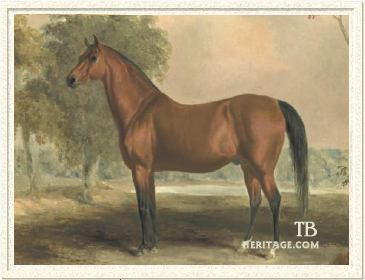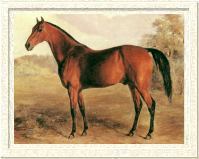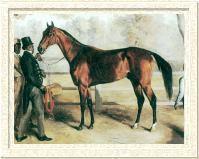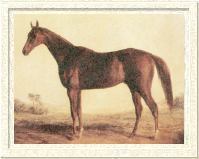|
|
Bertrand

|
|
 |
|
|
Bertrand was always considered, in conjunction with Sir Charles, as
one of the best sons of his sire, the great Sir Archy, both on the
track and as a stallion.
Bred by Col. John R. Spann of
Sumter County, South Carolina, his birthdate is recorded incorrectly
in the American Stud Book as 1821, when in fact, his breeder's records
indicate he was born on April 9, 1820. His dam was a sister to the
very good horse Gallatin, and she also produced Bertrand's younger
brother Pacific (1822), also by Sir Archy, also a good runner and
sire in Tennessee.
From the age of four, through
his five and six-year-old campaigns, Bertrand was the champion of
South Carolina, winning 13 of 15 starts, six of which were four-mile
heats and four were three-mile heats. He was better at the longer
distance, and his only two losses came at the shorter distance. It
was said Bertrand could accelerate with "quarter-miler speed"
at any point in a race, and doing so, devastated his opponents.
His most famous win came on February
25, 1826 at the Washington Course, Charleston, South Carolina. He
was engaged in an historic race with the team of Aratus and Creeping
Kate over three-mile heats. The strategy was to wear him down, and
in successsive heats, Aratus and Creeping Kate took turns pressuring
Bertrand, while the teammate raced more comfortably in the rear to
remain fresh for the next heat. The only problem here was Bertrand's
tremendous recouperative powers went far beyond anyone's expectations.
Aratus took the first heat by
a half-length over Bertrand, with Creeping Kate third.
The
roles were reversed in the second heat, which Creeping Kate won by
a half length over Bertrand, and Aratus third. In the third heat,
Bertrand went to the front and never relinquished command, defeating
Creeping Kate by a a length. In the fourth heat, Creeping Kate was
withdrawn, and a relatively fresh Aratus went to the front, but Bertrand
battled back and maintained a furious half-length lead over his rival
to the finish. The final time of 23:20 for the 12 miles shaved over
30 seconds off the previous record set by American Eclipse when he
defeated Henry in their famous North-South Match in 1824.
At the end of his racing in 1826,
Bertrand was sold to John Lindsay of Lexington, Kentucky for the controversially
low price of $3,250. South Carolina was outraged, and breeder Spann
soon regretted the sale. Bertrand was sent to the farm of John Hutchcraft
in Bourbon County, Kentucky. (The farm is described as nine miles
north of Lexington on the Paris Pike, a location which would put it
just over the Bourbon County line near where Lemons Mill Pike intersects,
in the region of Duntreath Farm.) There he stood for 12 seasons with
much success. Lindsay, it was said, refused an offer of $35,000 for
his champion, who quickly became the most popular stallion in Kentucky,
covering nearly two hundred mares each season. |
 | |  |
 | |
Top left: Woodpecker, Undefeated and a top sire of the 1830s
Top right: Captain Viley's Richard Singleton, a great four-miler
Bottom left: John Bascombe won a great North-South match against Post Boy for his owner Col. John Crowell, owner of one of the South's most important racing stables, situated on vast acreage in Alabama.
All images courtesy ©National Racing Museum. Used with permission. |
His best runner was the undefeated
Woodpecker (b.c.1828 out of a mare by *Buzzard). Bertrand also sired
the top runners Richard Singleton (c. 1828 out of Black Eyed Susan
by Tiger), John Bascombe (c. out of Grey Goose by Pacolet), Fanny
Wright (f. 1832 out of Marcella by Sir Alfred; a queen of the Southern
turf), Grey Fanny (f. 1832 out of a mare by *Buzzard), Bertrand Jr.
(c. out of Harris' Buzzard mare by *Buzzard), Arbaces and Bill Austin.
He was the Leading Sire in 1835, and second in 1834 and 1836.
Bertrand's son Woodpecker sired
two animals of special importance, the Kentucky hero Grey Eagle, and
the mare Falcon, who became the third dam of the great Hanover. Bertrand
Jr. sired Hero.
Bertrand's daughters left a more
lasting impact, however. Quiz produced Nantura, herself dam of the
legendary Longfellow, and granddam of champion Ten Broeck. Gray Fanny
produced Grey Medoc and Blue Bonnet (dam of Lightning, Lodestone,
Nebula and was the second dam of Asteroid), Argentile was the dam
of Minnie Mansfield (dam of Katie Pease and Hubbard), Mary Hunt was
the dam of Margaret Hunter (second dam of Aristides).
Bertrand died in Kentucky in
1838 at the age of 17. The famous portrait of him painted by Edward
Troye (on display in the National Museum of Racing at Saratoga) shows
a bright, almost golden bay horse with both hind ankles white.
--Anne Peters
|
|
|
|

